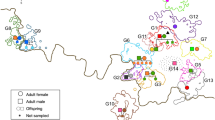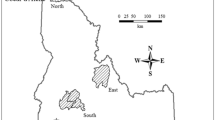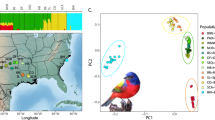Abstract
While extra-pair mating prevails among socially monogamous birds, it does not occur in all individuals within a population. Then, what underlies this variability? A poorly explored mechanism is the genetic contribution to the behavioral trait, especially for cooperatively breeding species where promiscuity may potentially conflict with the acquisition of indirect benefits to altruistic helpers. We addressed the gap through a quantitative genetic approach with 8 years of data from an individually marked population of Tibetan ground tits (Pseudopodoces humilis). Extra-pair mating was observed in 33.2% of nests, and cooperative breeding occurred in 39.5% of nests. Animal models demonstrated no significant genetic component contributing to the variance in extra-pair mating both during a specific year and over an individual’s lifetime. Consequently, the heritabilities were not significantly different from zero. The lack of heritable variation in extra-pair mating can be accounted for by Fisher’s fundamental theorem of natural selection, which suggests that genotypes associated with this behavior facilitating reproductive success should have become widespread within the population. Furthermore, the fitness benefits derived from promiscuity were greater for breeders than those from receiving help; for helpers, the fitness benefits from extra-pair mating outweighed the indirect genetic benefits obtained from providing help. This may explain why extra-pair mating and cooperative breeding can coexist in the same population. Our findings imply that individual variation in performing extra-pair mating behavior is more likely to be influenced by environmental factors.
This is a preview of subscription content, access via your institution
Access options
Subscribe to this journal
Receive 12 print issues and online access
$259.00 per year
only $21.58 per issue
Buy this article
- Purchase on SpringerLink
- Instant access to full article PDF
Prices may be subject to local taxes which are calculated during checkout

Similar content being viewed by others
Data availability
Data used in this study are available in the Figshare Digital Repository (https://figshare.com/s/27576e52c169c120418e).
References
Amadeu RR, Garcia AAF, Munoz PR, Ferrão LFV (2023) AGHmatrix: Genetic relationship matrices in R. Bioinformatics 39(7):btad445.
Arct A, Drobniak SM, Cichoń M (2015) Genetic similarity between mates predicts extrapair paternity—a meta-analysis of bird studies. Behav Ecol 26(4):959–968.
Arnqvist G, Kirkpatrick M (2005) The evolution of infidelity in socially monogamous passerines: the strength of direct and indirect selection on extrapair copulation behavior in females. Am Nat 165(S5):S26–S37.
Brouwer L, Griffith SC (2019) Extrapair paternity in birds. Mol Ecol 28(22):4864–4882.
Colombelli-Négrel D, Schlotfeldt BE, Kleindorfer S (2009) High levels of extra-pair paternity in Superb fairy-wrens in south Australia despite low frequency of auxiliary males. Emu 109(4):300–304.
Cornwallis CK, West SA, Davis KE, Griffin AS (2010) Promiscuity and the evolutionary transition to complex societies. Nature 466(7309):969–972.
de Villemereuil P, Gimene O, Doligez B (2013) Comparing parent-offspring regression with frequentist and Bayesian animal models to estimate heritability in wild populations: a simulation study for Gaussian and binary traits. Methods Ecol Evol 4(3):260–275.
Dillard JR, Westneat DF (2016) Disentangling the correlated evolution of monogamy and cooperation. Trends Ecol Evol 31(7):503–513.
Dobson S, Dunning J, Burke T, Chik HYJ, Schroeder J (2023) Indirect genetic effects increase heritability estimates for male and female extra-pair reproduction. Evolution 77(8):1893–1901.
Dochtermann NA, Schwab T, Anderson Berdal M, Dalos J, Royauté R (2019) The heritability of behavior: a meta-analysis. J Heredity 110(4):403–410.
Donohue K, Messiqua D, Pyle EH, Heschel MS, Schmitt J (2000) Evidence of adaptive divergence in plasticity: density-and site-dependent selection on shade-avoidance responses in Impatiens capensis. Evolution 54(6):1956–1968.
Falconer, DS (1981) Introduction to Quantitative Genetics. Longman Press, London.
Fisher, RA (1930) The Genetical Theory of Natural Selection. Clarendon Press, Oxford.
Forstmeier W, Martin K, Bolund E, Schielzeth H, Kempenaers B (2011) Female extrapair mating behavior can evolve via indirect selection on males. Proc Natl Acad Sci USA 108(26):10608–10613.
Griffith SC, Owens IPF, Thuman KA (2002) Extra pair paternity in birds: a review of interspecific variation and adaptive function. Mol Ecol 11(11):2195–2212.
Grinkov VG, Bauer A, Sternberg H, Wink M (2020) Heritability of the extra-pair mating behaviour of the pied flycatcher in Western Siberia. Peer J 8:e9571.
Hadfield JR (2010) MCMC methods for multi-response generalized linear mixed models: the MCMCglmm R Package. J Stat Softw 33(2):1–22.
Hamilton WD (1964) The genetical evolution of social behaviour. J Theor Biol 7(1):1–16.
Hatchwell BJ (1999) Investment strategies of breeders in avian cooperative breeding systems. Am Nat 154(2):205–219.
Hatchwell BJ, Komdeur J (2000) Ecological constraints, life history traits and the evolution of cooperative breeding. Anim Behav 59(6):1079–1086.
Hughes JM, Mather PB, Toon A, Ma J, Rowley I, Russell E (2003) High levels of extra-group paternity in a population of Australian magpies Gymnorhina tibicen: evidence from microsatellite analysis. Mol Ecol 12(12):3441–3450.
Ke DH, Lu X (2009) Burrow use by Tibetan ground tits Pseudopodoces humilis: coping with life at high altitudes. Ibis 151(2):321–331.
Kruuk LEB (2004) Estimating genetic parameters in natural populations using the “animal model. Phil Trans R Soc B 359(1446):873–890.
Kruuk LEB, Clutton-Brock TH, Slate J, Pemberton JM, Brotherstone S, Guinness FE (2000) Heritability of fitness in a wild mammal population. Proc Natl Acad Sci USA 97(2):698–703.
Li ZB, Chen SC, Wei S, Komdeur J, Lu X (2023) Should sons breed independently or help? Local relatedness matters. J Anim Ecol 92(11):2189–2200.
Maynard Smith J (1982) Evolution and the Theory of Games. Cambridge University Press, Cambridge.
Merilä J, Sheldon BC (1999) Genetic architecture of fitness and nonfitness traits: empirical patterns and development of ideas. Heredity 83(2):103–109.
Møller AP (1998) Sperm competition and sexual selection. In: Birkhead TR, Møller AP (eds) Sperm Competition and Sexual Selection, 1st edn. Academic Press, London
Plummer M (2017) JAGS version 4.3.0 user manual. https://sourceforge.net/projects/mcmc-jags/files/Manuals/4.x/.
R Core Team (2024) R: A language and environment for statistical computing. R Foundation for Statistical Computing, Vienna, Austria
Raj Pant S, Versteegh MA, Hammers M, Burke T, Dugdale HL, Richardson DS, Komdeur J (2022) The contribution of extra-pair paternity to the variation in lifetime and age-specific male reproductive success in a socially monogamous species. Evolution 76(5):915–930.
Reid JM, Arcese P, Sardell RJ, Keller LF (2011a) Additive genetic variance, heritability, and inbreeding depression in male extra-pair reproductive success. Am Nat 177(2):177–187.
Reid JM, Arcese P, Sardell RJ, Keller LF (2011b) Heritability of female extra-pair paternity rate in song sparrows (Melospiza melodia). Proc R Soc B 278(1708):1114–1120.
Rivers PR, DuVal EH (2020) Multiple paternity in a lek mating system: females mate multiply when they choose inexperienced sires. J Anim Ecol 89(5):1142–1152.
Roff DA, Mousseau TA (1987) Quantitative genetics and fitness: lessons from Drosophila. Heredity 58(1):103–118.
Sardell RJ, Arcese P, Keller LF, Reid JM (2012) Are there indirect fitness benefits of female extra-pair reproduction? Lifetime reproductive success of within-pair and extra-pair offspring. Am Nat 179(6):779–793.
Stutchbury BJ, Morton ES (1995) The effect of breeding synchrony on extra-pair mating systems in songbirds. Behaviour 132(9–10):675–690.
Teplitsky C, Mills JA, Yarrall JW, Merilä J (2009) Heritability of fitness components in a wild bird population. Evolution 63(3):716–726.
Wang C, Lu X (2011) Female ground tits prefer relatives as extra-pair partners: driven by kin-selection?. Mol Ecol 20(13):2851–2863.
Wang C, Lu X (2014) Extra-pair paternity in relation to breeding synchrony in ground tits: an individual-based approach. J Avian Biol 45(6):561–565.
Wang C, Lu X (2018) Hamilton’s inclusive fitness maintains heritable altruism polymorphism through rb = c. Proc Natl Acad Sci USA 115(8):1860–1864.
Webster MS, Tarvin KA, Tuttle EM, Pruett-Jones S (2007) Promiscuity drives sexual selection in a socially monogamous bird. Evolution 61(9):2205–2211.
Acknowledgements
We thank the past and present members of Ornithology Lab at Wuhan University for their field and laboratory work. We thank Dr. Daiping Wang for valuable suggestions on the earlier draft of this manuscript.
Funding
This work was supported by the National Natural Science Foundation of China (No. 31830085) and the Second Tibetan Plateau Scientific Expedition and Research Program (No. 2019QZKK0501).
Author information
Authors and Affiliations
Corresponding author
Ethics declarations
COMPETING INTERESTS
The authors declare no competing interests.
Ethics
Our study was approved by the Law of the People’s Republic of China on the Protection of Wildlife (reference 19881108) and Provisions of the Tibet Autonomous Region for the Protection of Wild Animals and Wild Plants (reference 20091001). The field protocol had no adverse effects on reproduction of the birds.
Additional information
Publisher’s note Springer Nature remains neutral with regard to jurisdictional claims in published maps and institutional affiliations.
Associate editor: Xiangjiang Zhan.
Rights and permissions
Springer Nature or its licensor (e.g. a society or other partner) holds exclusive rights to this article under a publishing agreement with the author(s) or other rightsholder(s); author self-archiving of the accepted manuscript version of this article is solely governed by the terms of such publishing agreement and applicable law.
About this article
Cite this article
Wei, S., Li, Z. & Lu, X. No evidence for heritability of extra-pair mating behavior in a cooperatively breeding bird. Heredity (2025). https://doi.org/10.1038/s41437-025-00796-4
Received:
Revised:
Accepted:
Published:
DOI: https://doi.org/10.1038/s41437-025-00796-4



